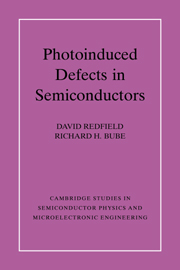Book contents
- Frontmatter
- Contents
- Preface
- 1 Introduction: Metastable Defects
- 2 III–V Compounds: DX and EL2 Centers
- 3 Other Crystalline Materials
- 4 Hydrogenated Amorphous Silicon: Properties of Defects
- 5 Hydrogenated Amorphous Silicon: Photoinduced Defect Kinetics and Processes
- 6 Other Amorphous Semiconductors
- 7 Photoinduced Defects in Devices
- References
- Index
3 - Other Crystalline Materials
Published online by Cambridge University Press: 15 December 2009
- Frontmatter
- Contents
- Preface
- 1 Introduction: Metastable Defects
- 2 III–V Compounds: DX and EL2 Centers
- 3 Other Crystalline Materials
- 4 Hydrogenated Amorphous Silicon: Properties of Defects
- 5 Hydrogenated Amorphous Silicon: Photoinduced Defect Kinetics and Processes
- 6 Other Amorphous Semiconductors
- 7 Photoinduced Defects in Devices
- References
- Index
Summary
CdS and CdSe
Descriptions of exotic effects as the result of photoexcitation of II–VI materials, particularly CdS and CdSe, can be found extending back to when Boer, Borchardt, and Borchardt (1954) reported temperature-dependent, slow decreases of photoconductivity with time of photoexcitation of CdS crystals. In this section we review some examples of these effects and the kinds of models that have been suggested. It must be admitted that genuinely authenticated models do not exist for many of these early photoinduced defect effects, and so we primarily call attention to the suggestions that investigators have made.
Apparently related effects were found by measurements of thermally stimulated conductivity depending on the temperature of photoexcitation before making the measurement, and in the effect of photoexcitation on impure CdS, particularly on CdS:Cu crystals showing both a decrease in bulk photoconductivity of the material and a reversible degradation of the junction collection properties of a CuxS/CdS heterojunction. The phenomenon of persistent photoconductivity has also been observed. In many cases decreases of luminescence with time under photoexcitation have been observed, paralleling the decrease in photoconductivity. A photoinduced defect interaction model for some of these kinds of effects has been described by Tscholl (1968).
Decrease in Photoconductivity with Time in CdS and CdSe
The experimental results at 100 °C of the original experiment of Boer and coworkers (Boer 1954, 1990 [p. 1101]; Boer, Borchardt, and Oberlander 1959) are shown in Figure 3.1.
- Type
- Chapter
- Information
- Photo-induced Defects in Semiconductors , pp. 50 - 78Publisher: Cambridge University PressPrint publication year: 1996



